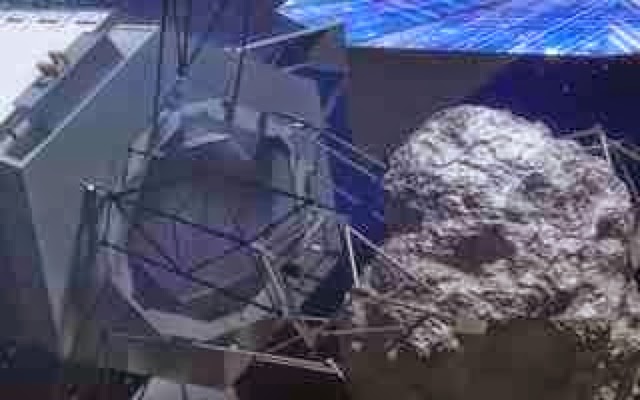She is approximately 6 meters and apparently contains a lot of empty space, or at least that is what the Spitzer is informing NASA. The Spitzer telescope (an infrared space observatory hanging out since 2003) is perched in space. In 2009 its liquid Helium supply used to cool the telescope was exhausted. Many of its instruments can no longer be used but the two shortest-wavelength modules of the IRAC camera are still operable with the same sensitivity as before the cryogen was exhausted, and will continue to be used in the Spitzer Warm Mission.
(Can you see her? Pictured below.)
Spitzer follows an unusual orbit, heliocentric not geocentric, and has a great view of asteroids and is better capable of getting their measurements.
Our latest candidate hails from near-Earth and was discovered on June 27th 2011 by robotic telescopes in New Mexico. You may remember her as the asteroid that made a close approach but just passed Earth by. There was no threat of collision and no worry as should it enter the Earth’s atmosphere it will likely burn up, maybe litter us with a few fireballs, but no big deal. But now 2011 MD is all grown up and has made the list for viable candidates for the ARM mission. Okay, she didn’t literally ‘grow’, but is actually the perfect size for the capture mission. The big final selection won’t happen for some time but then the mission isn’t scheduled until the 2020’s.
The stated objectives of this mission start with a rendezvous with an asteroid, capture it and then redirect/relocate it to a stable lunar environment, There NASA will demonstrate high-power solar propulsion. Obviously this entire event will allow them to do things they have never done before such as the capturing of large non-cooperative objects in space not to mention not to mention the detection and characterization of small near-Earth asteroids, something which is necessary through this mission from the planning potion on through.
In addition they will get to utilize assets currently under development such as the Orion/SLS and get familiar with the nuances before they are far away in deep space. Acting under the circumstances such as having limited communications as they go around the dark side of the moon.
The characteristics that the ARM mission seeks are of a size, certain mass, rotation rate, perhaps a stable orbit. Unfortunately these simple characteristics (and others) cannot necessarily be discerned when so far away by even our most powerful telescopes. The asteroids quickly move out of range before all can be adequately observed. The major difficulty is in identifying small asteroids as while a small size is a desirable characteristic, small asteroids reflect very little light and so can easily go unnoticed.
So at present our newest addition to the list is on a very short list. Worst case scenario she’s second runner up.
I would be remiss if I didn’t mention funding. Obviously funding is a big need and not just for this mission. Actually this mission has a lot of things going on that are needed regardless. If we had no ARM mission, we would still need to identify any asteroids out there as protection for Earth.As far as the Orion and SLS program, they need to be tested closer to home than say Mars and Mission Control and our astronauts need to work on not having conversations as frequent as during a spacewalk on the ISS. SO funding this mission needs to be seen as what it is, funding our safety, funding other advancement, and I’m not even offering what advantages we may gain from better understanding Asteroids.
So welcome to the group 2011 MD, we may be seeing you later!





No comments:
Post a Comment